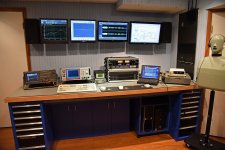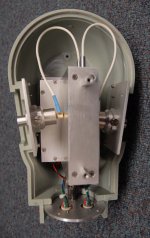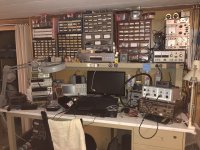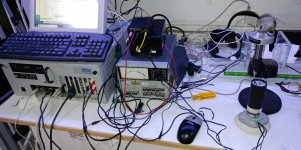You are using an out of date browser. It may not display this or other websites correctly.
You should upgrade or use an alternative browser.
You should upgrade or use an alternative browser.
What's on your workbench???
- Thread starter cnctooltek
- Start date
3585 appreciation society, I agree. Mine is an "A", you have a "B" model. Do you know what the difference is Suzy?
Back in the 80's HP made their own CPU chips using their proprietary SOS (Silicon On Sapphire) process. These chips were used in a lot of their test equipment. Unfortunately the process had problems and many chips had short lives, while others are still alive today.
Today there are several good semiconductor companies making SOI (Silicon On Insulator) chips. The "I" is usually silicon carbide, or even glass. Sapphire doesn't seem to be in the recipe. These chips are very fast.
The differences between the A and B model of some pieces of HP gear is simply the CPU chip and associated firmware. The CPU cards are different, and usually not compatible between A and B. I think the power supplies are different as well, due to the different voltage requirements for SOS.
Years ago I bought a 3585A very cheap, but found the CPU board to be dead. Replacements were impossible to find back then. I wound up selling the dead 3585A at a hamfest, cheap.
I believe the same issue occurs with the 8903A VS 8903B. I got two dead 8903A's cheap, both dead. One had a dead CPU board, the other a dead input board. I made one good unit from the pair, saved the spare cards and scrapped the uglier of the two cases. I have needed to replace two more cards with spares in the 20 years I have been using the instrument.
Today there are several good semiconductor companies making SOI (Silicon On Insulator) chips. The "I" is usually silicon carbide, or even glass. Sapphire doesn't seem to be in the recipe. These chips are very fast.
Peregrine semiconductor and more locally Silanna semiconductor do silicon on sapphire. The iPhone T/R switch was silicone on sapphire, keeping a bunch of foundries going for ages. I was part of a team that did a whole L-band direct down conversion radio on Silanna’s 0.25μ SoS process. Very cool process - fmax is essentially ft, and you can make really wonderful filters and high isolation switches in it.
Hi Suzy,
Yes, the 3585A has those outputs as well. The problem with that is the extra space for the display, but you can run one of these with an external display for sure.
Hi George,
-Chris
Yes, the 3585A has those outputs as well. The problem with that is the extra space for the display, but you can run one of these with an external display for sure.
Hi George,
That's what I have noticed with other HP instruments as for the difference between an A and B version. The 8901A and B have larger differences than that. I wish my 8901A was a B series!The differences between the A and B model of some pieces of HP gear is simply the CPU chip and associated firmware. The CPU cards are different, and usually not compatible between A and B. I think the power supplies are different as well, due to the different voltage requirements for SOS.
I have wanted to play with an 8903A or B. It would have to be cheap or not working for that to take place.I believe the same issue occurs with the 8903A VS 8903B. I got two dead 8903A's cheap, both dead. One had a dead CPU board, the other a dead input board. I made one good unit from the pair, saved the spare cards and scrapped the uglier of the two cases. I have needed to replace two more cards with spares in the 20 years I have been using the instrument.
-Chris
Hi Jack,
-Chris
Yes, that's probably the one I was talking about. I also agree that the 3585 seems to be more popular, but there isn't any shortages of 3577's out there either. I don't understand why they don't already have something for the 3585 yet. Maybe it's in the works. Just a time thing.There's a fella on EBay who sells an LCD replacement screen which works for the HP3577. I would imagine that the 3585A/B was an even more popular instrument warranting an LCD replacement.
-Chris
Peregrine semiconductor....you can make really wonderful filters and high isolation switches in it.
A co-worker left Motorola to work for Peregrine. He came to visit showing us a wafer that you could see through. We wound up co-developing some high powered RF switches with them that are now a catalog item. They were used as T/R and band switches in our 100 MHz to 900 MHz walkie talkies with up to 6 watts of RF power. The GaAs parts couldn't survive load mismatch testing.
have wanted to play with an 8903A or B. It would have to be cheap or not working for that to take place.
I got two dead 8901A's for $125, maybe 25 years ago. That qualifies for both cheap and not working. I had a live 8901A but sold it at a hamfest a few years back. I had it for 15 years or so and never used it.
I enjoy these topics where people share images of their work-spaces. I have read several books about shop layout and I have visited many commercial and home shops. Everyone is different. We can learn from others to improve our own.
Here is one of my benches. I put this together to be flexible so it could be used for a variety of projects. By flexible I mean that the instruments don't "live" there but are placed on the bench as needed. It is shown set up for testing dispatcher headsets.
Here is one of my benches. I put this together to be flexible so it could be used for a variety of projects. By flexible I mean that the instruments don't "live" there but are placed on the bench as needed. It is shown set up for testing dispatcher headsets.
Attachments
Hi xmo,
I have to agree with Demian.
A really pretty bench though, I have to hand it to you. Most of my old gear lives on the bench with benchtop room for visitors.
-Chris
I have to agree with Demian.
I'll second that! Doing any kind of construction on a clean bench results in an extremely filthy bench! You need vacuum cleaners and sometimes solvents to clean up those messes.Its almost too clean to do any development work.
A really pretty bench though, I have to hand it to you. Most of my old gear lives on the bench with benchtop room for visitors.
-Chris
This bench isn't used for construction so it can stay clean during a project such as comparing a variety of communications headsets.
As far as the HATS - yes they're really expensive. I know I am insane, but not THAT insane.
I started this project thinking something like: "how hard can it be to test headsets. Just get a dummy head and put a microphone in his ear."
Then I learned about Zwislocki, IEC60318, and so-on. OK - so it's complicated.
I looked high and low for an affordable solution (still looking). I did stumble on this 4128C for (sort-of) cheap - the catch is - all I got is an empty shell.
I have no idea what B&K actually puts in there. I could never find any detailed images, only a couple drawings in their literature. So I did the best I could. First I created an artificial mouth. That's not too hard. You can verify that with a measurement microphone placed in the correct location.
The ears are a different matter. I decided to create two sets of couplers. One is the simple microphone at the ear entrance - that makes the HATS somewhat like the B&K4100D.
I really couldn't find enough detail on the IEC coupler so I made a pair that approximate the XD-1053.
Here's what the inside of his head looks like:
As far as the HATS - yes they're really expensive. I know I am insane, but not THAT insane.
I started this project thinking something like: "how hard can it be to test headsets. Just get a dummy head and put a microphone in his ear."
Then I learned about Zwislocki, IEC60318, and so-on. OK - so it's complicated.
I looked high and low for an affordable solution (still looking). I did stumble on this 4128C for (sort-of) cheap - the catch is - all I got is an empty shell.
I have no idea what B&K actually puts in there. I could never find any detailed images, only a couple drawings in their literature. So I did the best I could. First I created an artificial mouth. That's not too hard. You can verify that with a measurement microphone placed in the correct location.
The ears are a different matter. I decided to create two sets of couplers. One is the simple microphone at the ear entrance - that makes the HATS somewhat like the B&K4100D.
I really couldn't find enough detail on the IEC coupler so I made a pair that approximate the XD-1053.
Here's what the inside of his head looks like:
Attachments
This bench isn't used for construction so it can stay clean during a project such as comparing a variety of communications headsets.
As far as the HATS - yes they're really expensive. I know I am insane, but not THAT insane.
I started this project thinking something like: "how hard can it be to test headsets. Just get a dummy head and put a microphone in his ear."
Then I learned about Zwislocki, IEC60318, and so-on. OK - so it's complicated.
I looked high and low for an affordable solution (still looking). I did stumble on this 4128C for (sort-of) cheap - the catch is - all I got is an empty shell.
I have no idea what B&K actually puts in there. I could never find any detailed images, only a couple drawings in their literature. So I did the best I could. First I created an artificial mouth. That's not too hard. You can verify that with a measurement microphone placed in the correct location.
The ears are a different matter. I decided to create two sets of couplers. One is the simple microphone at the ear entrance - that makes the HATS somewhat like the B&K4100D.
I really couldn't find enough detail on the IEC coupler so I made a pair that approximate the XD-1053.
Here's what the inside of his head looks like:
The inside is a pretty clean work. How a B&K HATS got separated from its key components would be an interesting story. The HATS usually has a 711 coupler (similar to a Zwislocki or IEC) but done a little differently. The rubber ears are silly expensive, let alone the rest. I have a Gras artificial ear (really expensive for 1 ear) and use it occasionally when I need to check to international standards but for audio its not that helpful. My best and most consistent results come from a flat plate with a small ECM mike in the center.
Back when Knowles was making the original Kemar, Plantronics did some published measurements that showed there is no way to compare results between different HATS. No correction etc. would help. Further no two ears hear the same anyway and despite all the noise you may read the target curves are not that useful. In commercial terms the most successful headphones depart A LOT from accepted standards.
As a counterpoint here is my acoustic bench from some recent work. I have never been able to chase many of the cables away.
There is an HP SLM and mike preamp w/ B&K 1" pressure calibrated mike with an NBS 9A coupler under that mess. But I'm testing an earcup with noise cancelling with its internal microphone after calibrating with the HP setup.
Attachments
Great benchtop multimeter obsession.
3 bench top DVM, two are Fluke 8050/8010 and a Keithley 2002 😀
1 Agilent 1732B LCR bridge (orange thing to right)
HP 5315A Totalizer/frequency counter
HP 8116A Pulse function generator
So really just three plus a cheap handheld meter. Tubelab is of the opinion you can't have too many (cheap) DVMs. I agree - of the 3 only the Keithley was expensive.
Hey Kevin,
What is that CD player you have there front and centre?
<snip>
-Chris
It's a Sony SCD-XB770 SACD player sold in the UK and possibly the EU as well - not sold here. (240V only) It is 5.1 surround sound capable, and has a completely redesigned clock system which despite the effort (master clock with dividers as opposed to the multiplier based set up Sony used) sounds like shite. It's a lab mule for SPDIF signals and audio from back in the days when I had no convenient source for testing with actual music. It's basically obsolete, if I need SPDIF I will use a usb adaptor to get it.
Full of Sony proprietary DSD decoder and DAC ICs, from back in the days when Sony was still in the semi-conductor business.
I suspect the layout is nothing more than coincidence, the DCD S10 is a much better player than this piece of junk. The DCD is also a slightly older player unless I miss my guess, mine is about 12 years old I guess.
It was a failed experiment, and I ended up biting the bullet and purchasing a very lightly used SCD-777ES from a friend for about 4X what the XB770 cost me.
I suspect the layout is nothing more than coincidence, the DCD S10 is a much better player than this piece of junk. The DCD is also a slightly older player unless I miss my guess, mine is about 12 years old I guess.
It was a failed experiment, and I ended up biting the bullet and purchasing a very lightly used SCD-777ES from a friend for about 4X what the XB770 cost me.



